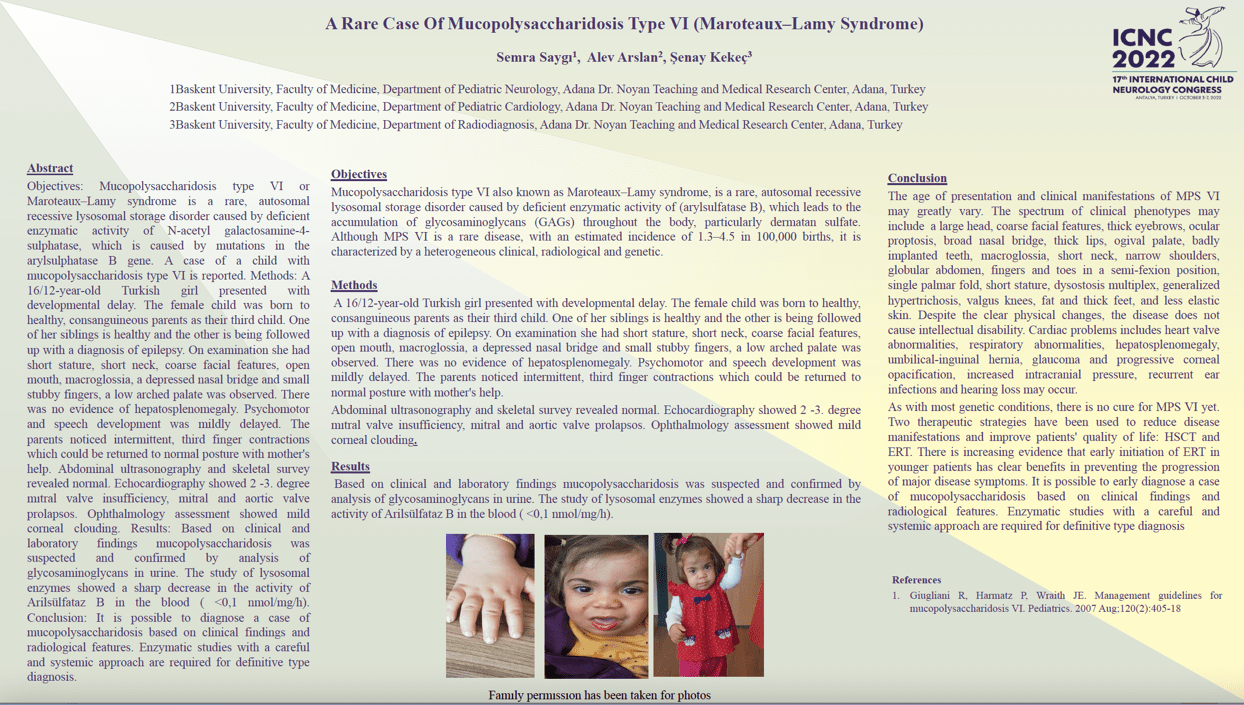A Rare Case Of Mucopolysaccharidosis Type VI (Maroteaux–Lamy Syndrome)
SEMRA SAYGI, ALEV ARSLAN, ŞENAY DEMİR
Objectives: Mucopolysaccharidosis type VI or Maroteaux–Lamy syndrome is a rare, autosomal recessive lysosomal storage disorder caused by deficient enzymatic activity of N-acetyl galactosamine-4-sulphatase, which is caused by mutations in the arylsulphatase B gene. A case of a child with mucopolysaccharidosis type VI is reported. Methods: A 16/12-year-old Turkish girl presented with developmental delay. The female child was born to healthy, consanguineous parents as their third child. One of her siblings is healthy and the other is being followed up with a diagnosis of epilepsy. On examination she had short stature, short neck, coarse facial features, open mouth, macroglossia, a depressed nasal bridge and small stubby fingers, a low arched palate was observed. There was no evidence of hepatosplenomegaly. Psychomotor and speech development was mildly delayed. The parents noticed intermittent, third finger contractions which could be returned to normal posture with mother's help. Abdominal ultrasonography and skeletal survey revealed normal. Echocardiography showed 2 -3. degree mıtral valve insufficiency, mitral and aortic valve prolapsos. Ophthalmology assessment showed mild corneal clouding. Results: Based on clinical and laboratory findings mucopolysaccharidosis was suspected and confirmed by analysis of glycosaminoglycans in urine. The study of lysosomal enzymes showed a sharp decrease in the activity of Arilsülfataz B in the blood ( <0,1 nmol/mg/h). Conclusion: It is possible to diagnose a case of mucopolysaccharidosis based on clinical findings and radiological features. Enzymatic studies with a careful and systemic approach are required for definitive type diagnosis.
Keywords: Mucopolysaccharidosis type VI, Maroteaux–Lamy syndrome, Arilsülfataz B, developmental delay
SEMRA SAYGI
Baskent University, Faculty of Medicine
Turkey
ALEV ARSLAN
Baskent University, Faculty of Medicine
Turkey
ŞENAY DEMİR
Baskent University, Faculty of Medicine
Turkey
Objectives: Mucopolysaccharidosis type VI or Maroteaux–Lamy syndrome is a rare, autosomal recessive lysosomal storage disorder caused by deficient enzymatic activity of N-acetyl galactosamine-4-sulphatase, which is caused by mutations in the arylsulphatase B gene. A case of a child with mucopolysaccharidosis type VI is reported. Methods: A 16/12-year-old Turkish girl presented with developmental delay. The female child was born to healthy, consanguineous parents as their third child. One of her siblings is healthy and the other is being followed up with a diagnosis of epilepsy. On examination she had short stature, short neck, coarse facial features, open mouth, macroglossia, a depressed nasal bridge and small stubby fingers, a low arched palate was observed. There was no evidence of hepatosplenomegaly. Psychomotor and speech development was mildly delayed. The parents noticed intermittent, third finger contractions which could be returned to normal posture with mother's help. Abdominal ultrasonography and skeletal survey revealed normal. Echocardiography showed 2 -3. degree mıtral valve insufficiency, mitral and aortic valve prolapsos. Ophthalmology assessment showed mild corneal clouding. Results: Based on clinical and laboratory findings mucopolysaccharidosis was suspected and confirmed by analysis of glycosaminoglycans in urine. The study of lysosomal enzymes showed a sharp decrease in the activity of Arilsülfataz B in the blood ( <0,1 nmol/mg/h). Conclusion: It is possible to diagnose a case of mucopolysaccharidosis based on clinical findings and radiological features. Enzymatic studies with a careful and systemic approach are required for definitive type diagnosis.
Keywords: Mucopolysaccharidosis type VI, Maroteaux–Lamy syndrome, Arilsülfataz B, developmental delay
SEMRA SAYGI
Baskent University, Faculty of Medicine
Turkey
ALEV ARSLAN
Baskent University, Faculty of Medicine
Turkey
ŞENAY DEMİR
Baskent University, Faculty of Medicine
Turkey

SEMRA SAYGI
Baskent University, Faculty of Medicine Turkey
Baskent University, Faculty of Medicine Turkey